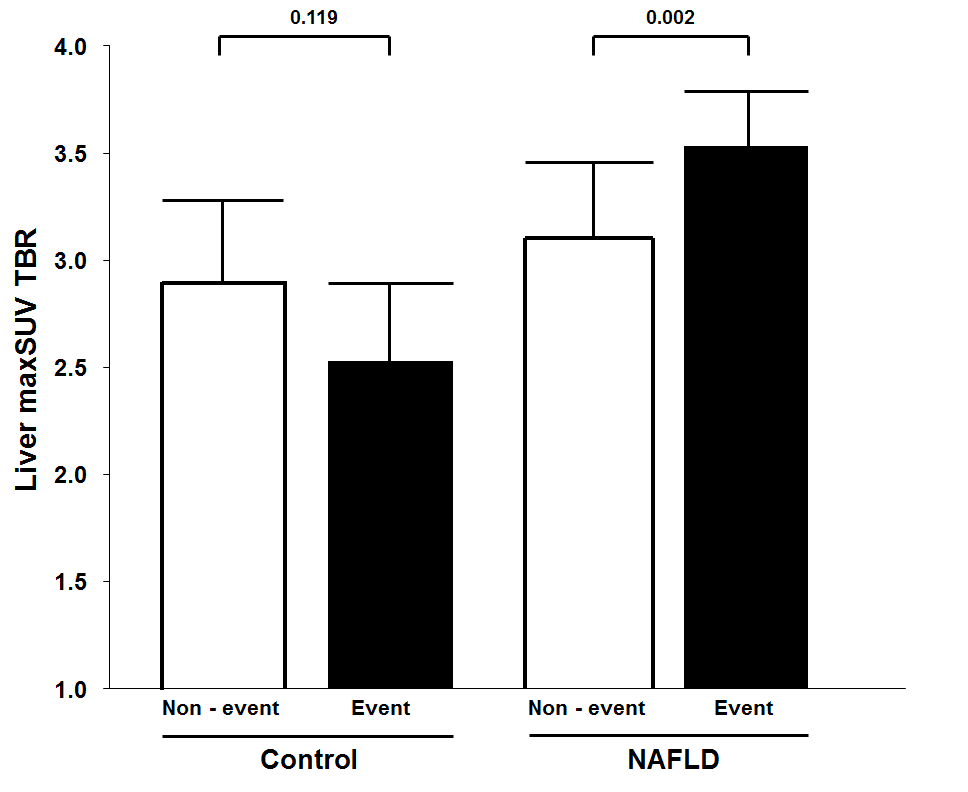글로벌 연구동향
핵의학
![[J Nucl Cardiol.] Hepatic FDG uptake is associated with future cardiovascular events in asymptomatic individuals with non-alcoholic fatty liver disease](/enewspaper/upimages/admin_20170717163237_R.jpg) 2017년 07월호
2017년 07월호
[J Nucl Cardiol.] Hepatic FDG uptake is associated with future cardiovascular events in asymptomatic individuals with non-alcoholic fatty liver disease성균관의대 / 문승환, 이경한*
- 출처
- J Nucl Cardiol.
- 등재일
- 2017 Jun
- 저널이슈번호
- 2017 Jun;24(3):892-899. doi: 10.1007/s12350-015-0297-y. Epub 2015 Oct 28.
- 내용

Figure legend: Comparison of liver maximum target-to-blood pool ratio (M-TBR) in control and NAFLD groups subcategorized according to cardiovascular events. Bars are mean ± SD. Mann-Whitney test was used for comparisons between groups.
Abstract
BACKGROUND:
Hepatic F-18 fluoro-2-deoxyglucose (FDG) uptake is associated with non-alcoholic fatty liver disease (NAFLD) which is an independent risk factor for cardiovascular disease. However, the value of hepatic FDG uptake for predicting future cardiovascular events has not been explored.
METHODS AND RESULTS:
Study participants were 815 consecutive asymptomatic participants who underwent a health screening program that included FDG positron emission tomography/computed tomography (PET/CT), abdominal ultrasonography, and carotid intima-media thickness (CIMT) measurements (age 51.8 ± 6.0 year; males 93.9%). We measured hepatic FDG uptake and assessed the prognostic significance of this parameter with other cardiovascular risk factors including Framingham risk score and CIMT. Multivariate Cox proportional hazards analyses including all study participants revealed that NAFLD with high-hepatic FDG uptake was the only independent predictor for future cardiovascular events [hazard ratio (HR) 4.23; 95% CI 1.05-17.04; P = .043). Subgroup analysis conducted in the NAFLD group showed that high-hepatic FDG uptake was a significant independent predictor of cardiovascular events (HR 9.29; 95% CI 1.05-81.04; P = .045).
CONCLUSIONS:
This exploratory study suggests that high-hepatic FDG uptake may be a useful prognostic factor for cardiovascular events in individuals with NAFLD.
Author information
Moon SH1, Hong SP1, Cho YS1, Noh TS1, Choi JY1, Kim BT1, Lee KH2.
1 Department of Nuclear Medicine and Molecular Imaging, Samsung Medical Center, Sungkyunkwan University School of Medicine, 50 Irwon-dong, Gangnam-gu, Seoul, 135-710, Republic of Korea.
2 Department of Nuclear Medicine and Molecular Imaging, Samsung Medical Center, Sungkyunkwan University School of Medicine, 50 Irwon-dong, Gangnam-gu, Seoul, 135-710, Republic of Korea. khnm.lee@samsung.com.
- 키워드
- PET/CT imaging; coronary artery disease; fluorodeoxyglucose (FDG); non-alcoholic fatty liver disease (NAFLD); prognosis
- 연구소개
- Non-alcoholic fatty liver disease (NAFLD) 환자들에서 cardiovascular disease (CVD)의 위험성이 높다는 것은 잘 알려져 있는데 liver의 inflammation이 NAFLD와 CVD와의 연관성을 매개하는 process일 것이라고 많은 연구자들은 생각하고 있습니다. FDG uptake는 inflammation 을 반영하기 때문에 liver의 FDG uptake가 결과적으로 CVD risk를 예측하는 factor가 될 수 있을 것이라 가정하였고 multivariate Cox proportional-hazards analyses를 통해 이를 확인하였습니다. Inflammation과 CVD 사이에 관계에 관심이 많으신 연구자들에게 소개 및 도움이 될 만한 좋은 정보라 생각합니다.
- 덧글달기








편집위원
FDG PET 상 간섭취 증가가 미래의 심혈관질환 발생 가능성을 예측할 수 있음을 보여 준 흥미로운 연구임. 핵의학 영상은 전신의 추적자 분포를 보여주는데, 표적 질환외 추적자 분포를 이용하여 임상적인 유용한 지표를 도출한 기발한 연구이다. 임상핵의학자에게 향후 연구 주제 발굴에 아이디어를 제공할 수 있는 유익한 논문으로 생각된다.
덧글달기닫기2017-07-07 15:34:49
등록